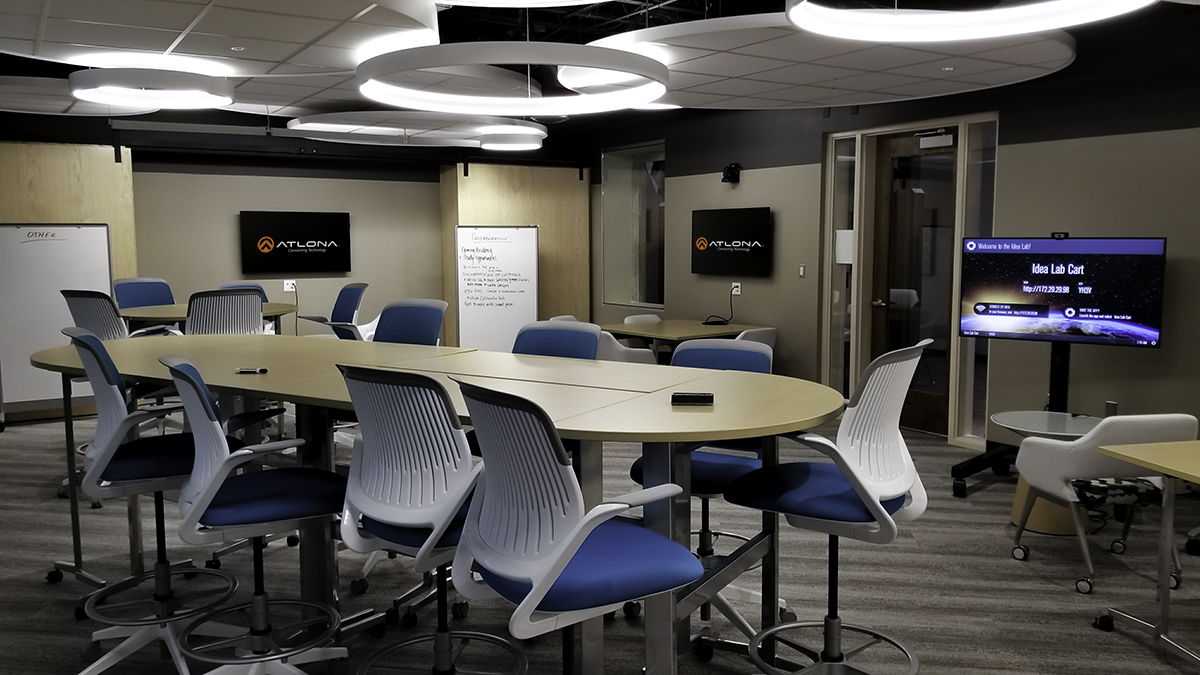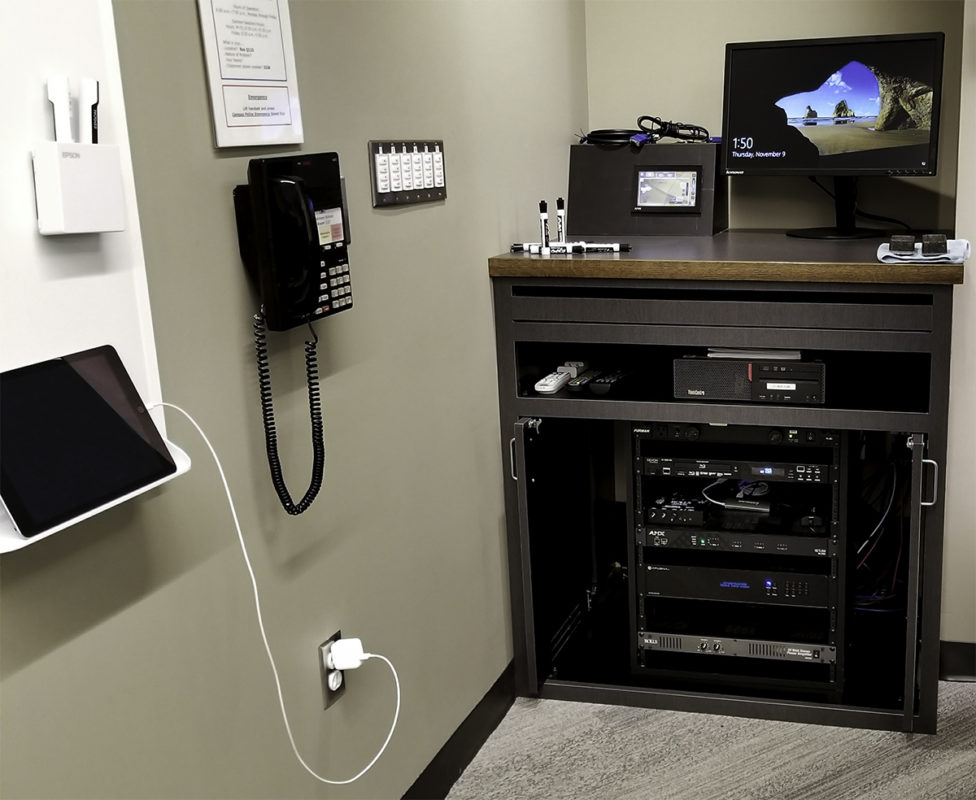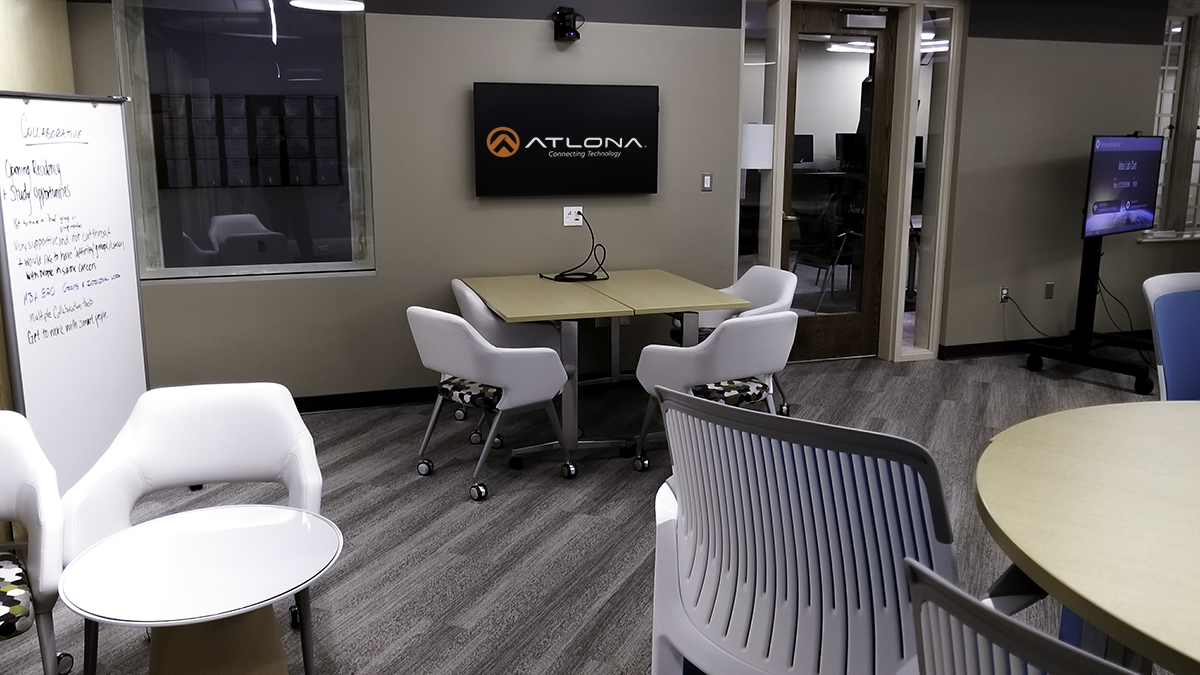
Case Study: University of Richmond
INVESTS IN COLLABORATIVE EDUCATION
Download the Case Study PDFMaking the grade for flexible connectivity and scalability in active learning environments, the University of Richmond in Virginia, selects Atlona’s CLSO-840 and CLSO-824 matrix presentation switchers to integrate today’s classroom technology while preparing for future updates.
Very few AV verticals require the same operational flexibility and extensive scalability as higher education. AV technology not only enhances learning for students across dozens or hundreds of classrooms, but also provides a critical foundation for non-instructional campus applications such as digital signage, wayfinding, and meeting rooms.
The role of collaborative presentations has become an intrinsic element of today’s active learning environments and teaching processes, as has the scale at which such AV systems are deployed and the pace at which AV technology evolves. Consistently meeting the needs of students and teachers requires the in-house support teams to stay ahead of trends and technology curves, while ensuring the solutions they choose scale seamlessly and deliver long-term value.

At the University of Richmond in Virginia, a selective and nationally ranked liberal arts university focused on creating new knowledge and educating ambitious students, the Telecommunications and Media Services and Support (TMSS) department supports the ever-expanding AV needs of more than 160 classrooms. Additionally, the department oversees another 80 AV-empowered, non-classroom campus spaces.
“In addition to developing technology solutions in support of campus renovation projects, or newly constructed spaces, we have a five-year strategy for refreshing technology in classrooms, and we’re also finding ourselves doing more rooms, with more displays,” said Doug West, assistant vice president for telecommunications, media services and support, user services, and academic computing services in the University of Richmond’s Information Services division. “We look for AV products that scale with us as our classroom environments grow more complex. Once we find something that works well, we tend to scale pretty quickly.”
While easy integration with the university’s existing systems was a key criterion, the team also wanted to find vendors with sufficiently broad offerings to match their varying project needs. This was especially true in the AV switching and distribution area, where requirements can vary greatly based on room size, I/O needs and other architectural factors.
“We looked at different switchers that would work within our environments and with our existing control systems, and found that many companies were discontinuing models too frequently and didn’t have scalable product lines,” explained Phil Sherman, senior engineer for the school’s Telecom and Media Services and Support department. “We needed to find one company that makes what we need, no matter what environment we’re going into. For video switching and distribution in our classrooms, that search led us to Atlona.”

Forward-Looking but Legacy-Friendly
While constantly looking towards the future, the media services team must also ensure that the solutions they choose will easily integrate with older equipment as well. For presentation switchers, that translates to a need for flexible connectivity to interface with varying generations of computers and devices.
“The computers in our meeting rooms and classrooms are on a shorter refresh cycle than our AV systems,” West explained. “The computer industry is somewhat driving changes in the types of connectors they use for connecting to AV systems. Upon making the transition analog to digital sources, from desktop computers to laptops, and from PCs to Macs, it’s been a challenge for our AV systems to keep up with these changes.
“At the same time, even products that are one generation removed from the latest hardware configuration of a computer can create connectivity issues, and we have gotten emergency calls to rush adapters over, especially when we have visiting professors or guest lecturers,” he continued. “That’s obviously disruptive to the presentation and to the learning process.”

The university’s input requirements are also not limited to computer signals. Other sources include Mersive Solstice Pod wireless content sharing devices, Epson document cameras, Blu-ray players, and even the occasional VHS VCR, all of which may be switched to Epson or Dukane projectors and other displays.
Working closely with trusted campus vendors, Sherman investigated several vendor options, and found Atlona’s switchers proved to be well-aligned with all of these needs.
“One of the advantages Atlona offers is that they strongly leverage HDBaseT,” said Sherman. “The HDBaseT inputs on the matrix switchers basically act as universal ports, which we can connect to less-expensive input plates that support both HDMI and VGA as needed. That lets us build fully-digital rooms while still supporting VGA for those who walk in without the very latest hardware configurations, and helps us make sure every dollar we spend is useful going forward instead of spending a lot of money to support dying technologies.”
“We look for AV products that scale with us as our classroom environments grow more complex. Once we find something that works well, we tend to scale pretty quickly.”
-Doug West, Assistant Vice President
Transitional Learning Environments
The University of Richmond started using Atlona switching solutions in April 2017, and has so far deployed them in roughly 30 spaces across the campus. The input and output flexibility of Atlona’s switching solutions is most evident in one of the university’s newest rooms, the eye lab, where an AT-UHD-CLSO-840 8×4 matrix switcher routes several inputs to three independent displays.
A trio of AT-HDVS-200-TX-WP wall plate switchers connects to the CLSO-840 via HDBaseT. Each wall plate automatically selects between its HDMI and VGA inputs when a source is connected, and notifies the room’s control system that a new device has been plugged in.
“In its simplest form, we wanted students to be able to walk into the room, see an available TV, plug their device into the system, and have the TV turn on automatically with the correct input selected – all without the student interfacing with our control system,” said Sherman. “Beyond that, we wanted people to be able to use the control touchscreen to intuitively do anything they wanted to do – sending video from any source, to any destination, within the room.The Atlona CLSO-840 enables us that freedom.”
For rooms requiring just two distinct outputs, Sherman selected Atlona’s AT-UHD-CLSO-824 presentation matrix switcher. The CLSO-824 combines dual, mirrored HDBaseT and HDMI outputs with three HDBaseT, four HDMI and one multi-function analog video input, supporting a pair of projectors while offering VGA connectivity directly at the switcher or via HDBaseT-linked wall plates.
“The fact that Atlona products can be put directly on a network, that we can manage them remotely, and that we can perform updates to them over the network have all been pluses for us”
-West
While both switchers support the university’s environments requiring multiple discrete outputs, the majority of the school’s classrooms need only a single output signal. In these rooms, AT-UHD-SW-5000ED five-input switchers route HDMI and HDBaseT inputs to mirrored HDMI and HDBaseT outputs with automatic input selection. “It’s a straightforward 5×1 switcher that gives us the inputs we need for various media devices and the output for the projector,” said Sherman.
Broad Benefits
While space considerations weren’t one of the university’s highest priorities in evaluating new switchers, West has discovered their compact form factor to be a significant plus.
“There’s a lot of bang for the buck there as far as real estate is concerned,” he said. “Our teaching lectern is essentially a media cabinet that is usually installed in the corner of a room, where a faculty member interfaces with it to start driving the electronics. We’re able to replace 3RU systems with the half-rack-sized SW-5000ED, so they’re not generating a ton of heat in those cabinets, which may be closed up even while in use. And they fit easily in the rack spaces that we’re given to work with.”
“This has been a great relationship…We can count on Atlona over the long term.”
-West
Sherman also highlighted the remote maintainability of the Atlona switchers using the Atlona Management System as beneficial. “The fact that Atlona products can be put directly on a network, that we can manage them remotely, and that we can perform updates to them over the network have all been pluses for us.”
Beyond the positive feedback on the performance of the Atlona products, the TMSS team is also very pleased with the customer service that they have received from the company. “Atlona’s support has been very responsive when we’ve needed them,” said West. “The couple of times we’ve really had to get technical on something with them, they have come through for us and helped us with solving an issue.”
“The Atlona support team has worked well with us, and not just with our integrators,” echoed Sherman. “Some companies don’t really want to talk to end users, requiring us to have an integrator call them instead when we need help. That’s not the case with Atlona, and this has been a great relationship.”
Conclusion
The 4K capabilities of Atlona’s switchers provide future-proof comfort for the university, which will start doing some installations that incorporate Ultra HD video in the coming year. But in the meantime, the team is enjoying the practical benefits that help make their AV strategy a reality.
“We are fortunate to be able to evaluate and deploy new technologies like the Atlona switches, and University of Richmond faculty embrace the use of it in their teaching, and that’s something we’re especially proud of,” concluded West.
| Model | Description |
| AMS | Free, powerful software resource for select Atlona IP-controllable products in commercial, educational, government and residential environments |
| AT-HDVS-200-TX-WP | 2×1 switcher and HDBaseT transmitter with an HDMI input plus a VGA input with audio |
| AT-UHD-CLSO-824 | 4K/UHD 8×2 matrix switcher with dual, HDBaseT and mirrored HDMI outputs for 4K/UHD @ 60Hz signals |
| AT-UHD-CLSO-840 | 4K/UHD 8×4 matrix switcher for HDMI and HDBaseT with eight inputs, four discrete outputs, flexible audio integration capabilities, and Ethernet-enabled 100 meter HDBaseT extension |
| AT-UHD-SW-5000ED | 5×1 switcher with two HDBaseT inputs, three HDMI inputs, mirrored HDMI and HDBaseT outputs, balanced audio outputs, automatic input selection, and automatic display control capability |







